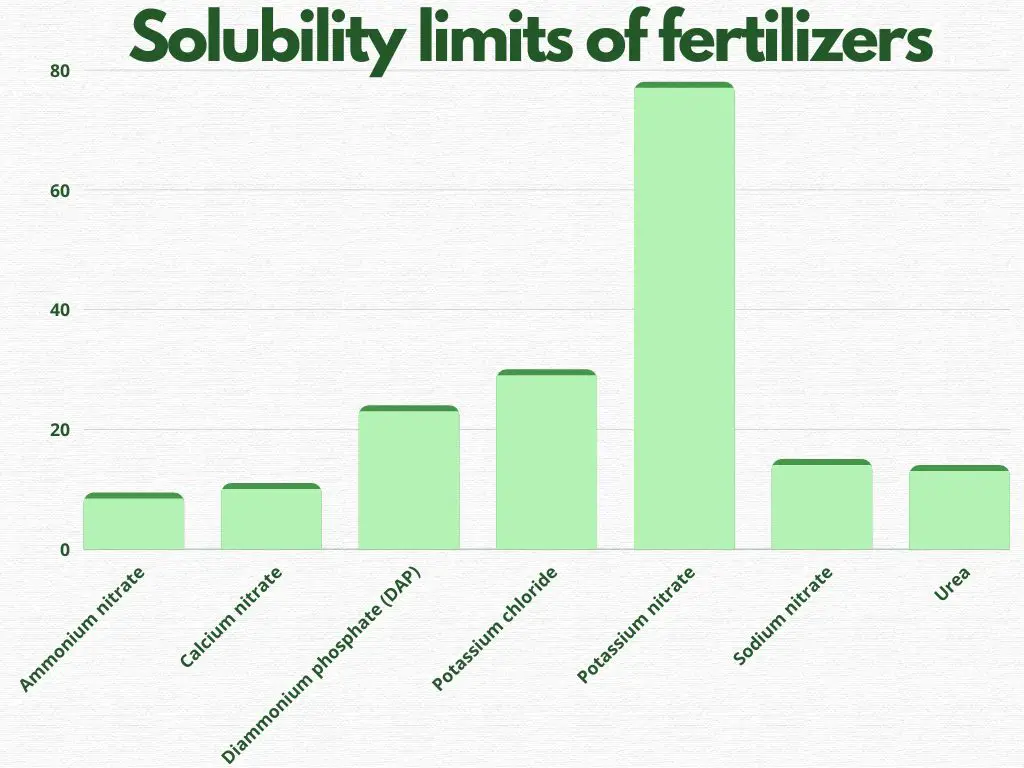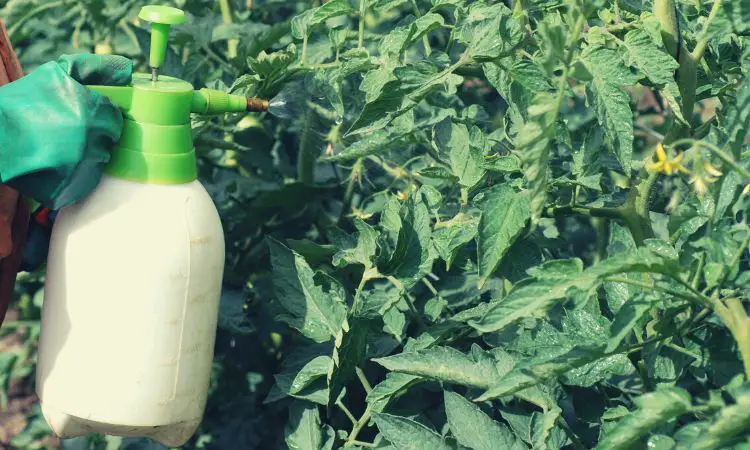In general, the Solubility of Granular Inorganic Fertilizers will take around 24 to 48 hours to dissolve completely. If you pour the granular fertilizer in warm water above room temperature, the dissolution rate will be higher and the temperature increase will impact solubility.
So, if temperature affects solubility then how long will it take to dissolve the granular fertilizer completely?
It is recommended that you add the granular fertilizer to your water tank gradually over a period of time so that the high concentration of nutrients does not shock and damage your plants.
When watering your plants with the fertilizer solution, be sure to apply the water directly to the root zone and avoid getting the leaves wet to reduce the risk of burning.
Note: Some nutrients like boron, calcium, zinc, magnesium, and manganese may be done with foliar spray. For this composition, you can directly use plants.
According to agricultural chemistry research, the foliar spray of granular fertilizer like calcium is much more effective than giving it to the soil. Because it will take a long time to transport into the plant cell.
What is granular fertilizer and how does it work?
Granular fertilizers are the dry, pelletized form of fertilizer that can directly used on the fields, Copland, or soil to provide nutrients for plants.
They are made from a variety of natural and synthetic materials, and each type of granular fertilizer contains different nutrients.
Most of the nutrients mechanism depend on physical contact with the soil to work properly.
Once the fertilizer granules come in contact with water, they begin to dissolve and release their nutrients into the soil solution.
The roots of plants then take up these nutrients and transport them to the leaves, where they are used for photosynthesis and other metabolic processes.
Here is a granular fertilizer list with their composition and dissolve rate.
Table: Solubility Table As per Time
Nitrogen fertilizers | Hygroscopic N fertilizers dissolve within 2-4 (hours ) |
Nitrogen fertilizers with inhibitors | About 1-2 weeks when applied to the soil |
Phosphorus fertilizers | 24 hours or more ( depends on both acidic and neutral to alkaline conditions) |
Potassium fertilizers: | 100% water soluble potash fertilizer dissolves rapidly ( depends on factor, 1-2 hours) |
Calcium, magnesium, and sulfur Fertilizers | ( Take similar time as NPK granular fertilizer) |
Micronutrient fertilizers | Dissolve rapidly (less than an Hour ) |
*Inhibitors: To prevent fertilizer from quickly dissolving.
How long does it take for granular fertilizer to dissolve in soil and water?
Granular fertilizers are a form of fertilizer that is applied directly to the soil's characteristics, so it will take time to build up the nutrients and realize them in a natural environment.
However, the time it takes for granular fertilizer to dissolve in the soil is quite brief, taking one to two days.
Some soils, such as super granular forms of fertilizer with a larger size than usual, dissolve to manage more time.
So it will concurrently realize nutrients to the plant's roots.
On the other hand, the dissolving mechanism of fertilizer in water depends on the temperature.
As the water temperature rises, the dissolve rate will parallelly increase and it takes less time to completely dissolve.
Suppose I want to give fertilizer to my vegetable garden, if you through granular fertilizer directly then the fertilizer management may not work properly as you can't guarantee that every portion of the garden gets the fertilizer.
Keep that in mind, if you do a dissolving granular fertilizer water solution to the garden as irrigation water, then it will work perfectly.
The factual table of Extension Service of Mississippi State University, U.S. Department of Agriculture. by GARY B. JACKSON shows the Solubility limits of fertilizers in-room water:
That means if you use the given ration of each fertilizer and water mix then it will be totally dissolved in water. Otherwise, the excess fertilizer will precipitate which is known as “salting out”
Table 2. Solubility limits of fertilizers as per rate.
Fertilizer | Pounds Per 100 Gallons |
|---|---|
Ammonium Nitrate | 984 (8.4:1 Means 1 G Ammonium Nitrate And 8.4 G Water) |
Calcium Nitrate | 851 (10:1) |
Diammonium Phosphate (DAP) | 358 (23:1) |
Potassium Chloride (Kcl) | 290 (29:1) |
Potassium Nitrate | 108 (77:1) |
Sodium Nitrate | 608 (14:1) |
Urea | 651 (13:1) |

What are the factors affecting granular fertilizer dissolve rate?
The granular fertilizer dissolve rate depends on the various factors of nature.
Soil
If the fertilizer is applied on dry soil, it will take time to dissolve and provide nutrients to plants.
However, if the fertilizer is applied on wet or damp soil, it will take less time for the fertilizer to completely dissolve.
So if you want to dissolve the fertilizer really quick then you can go with wetland cultivation or make the solution directly apply to the soil.
Water temperature.
As the water temperature rises, the dissolve rate will parallelly increase and it takes less time to completely dissolve.
So in the wintertime, the dissolution rate will be less and you can make it fast by using hot water solution or by irrigation or foliar apply( if land is small)
Fertilizer particle size.
The larger the particle size, the longer it will take for fertilizer to dissolve in water or soil completely. The smaller the particle size, the faster it will dissolve in water or soil.
Fertilizer itself.
Some fertilizers are made to work more slowly, releasing nutrients over a longer period of time. These fertilizers often have an inhibitor added to them to help slow down the release of nutrients.
As I talked before Nitrogen fertilizers with inhibitors will take the highest time to dissolve totally with the soil and water.
By the way, the 18-18-18 fertilizer maybe a good choice if you want to use for your personal garden or lawn care.
Ph level.
As far as I know from my agricultural study, the Ph level is one of the most important factors to consider when applying fertilizer because it can affect how well the plant can take up nutrients from the soil.
Like the granule dissolution rate for struvite (magnesium ammonium phosphate) ranged from 0.03 mg d−1 in alkaline soil to0.43 mg d−1 in acidic soil, similar to what was observed in our listed table.
The ideal pH level for most plants is between 6.0 and 7.0.
If the soil is too acidic (pH below 6.0), it can cause nutrient deficiencies in plants. If the soil is too alkaline (pH level above 7.0), it can also cause nutrient deficiencies.
Soil pH levels can be affected by many things, including the type of fertilizer you use. For example, ammonium sulfate is a fertilizer that can lower soil pH levels.
Amount of fertilizer you apply.
If you apply too much fertilizer, it can actually cause damage to plants. This is because the roots can't take up all the nutrients they need and the excess fertilizer can actually burn the roots.
Applying too little fertilizer will not provide enough nutrients for plants and can result in stunted growth.
Type of plant you are growing.
Some plants require more fertilizer than others. For example, plants that are grown for their flowers or fruits often need more fertilizer than plants that are grown for their leaves or stems.
The Last factor is the time of year.
Plants need more fertilizer during their growing season than they do during their dormant season. This is because they are actively growing and using up nutrients during the growing season.

Liquid form of fertilizer is sprayed over the plants , the dissolution rate imparts.
What are the benefits of using granular fertilizer over other types of fertilizers?
Mostly granular fertilizers are used because
- Easy to store and transport.
- Can be applied evenly over a large area.
- They last longer in the soil than other types of fertilizers.
- They release nutrients slowly, so plants can take up nutrients over a long period of time.
What are the drawbacks of using granular fertilizers?
- Can be difficult to apply evenly.
- Blown away by the wind.
- Can be washed away by heavy rains.
- They can be harmful to animals if they eat them.
Conclusion:
From the above guide, I have talked about several factors that will affect the granule fertilizer dissolution rate. So, the dissolve rate can withstand between one to two days, and sometimes it can take up to weeks.
It all depends on the type of fertilizer, particle size, soil type, and plant species. Also, the amount of fertilizer applied and time of year are important factors to consider.
If you have any more questions, please feel free to contact us.

I am a graduate of Bangladesh Agricultural University, where I delved into various agricultural disciplines, equipping me with a profound understanding of agriculture. Beyond academics, I have hands-on experience in gardening and crop cultivation. My passion is to embrace sustainable farming and horticulture. With a BSc in Agriculture, I am dedicated to promoting environmentally conscious and efficient agrarian practices.
Bachelor of Science (BSc) in Agriculture (Hons.)
Master of Science. (Sustainable Agriculture & Food Security ) (MS)
Bangladesh Agricultural University




